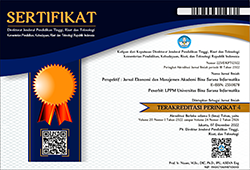Pengaruh Jalur Transmisi Kebijakan Moneter terhadap Inflasi di Indonesia
Abstract
Historically, actual inflation could not reach the inflation target, resulting in a deviation between the actual inflation and the inflation target. To overcome this problem, Bank Indonesia implemented a monetary policy transmission channel for inflation in Indonesia through the loan interest rate channel, the exchange rate channel, and the consumption credit channel. This article aims to determine the effect of the monetary policy transmission channel on inflation in Indonesia, as seen from the interest rate, exchange rate, and consumption credit channels. The research method of this article is quantitative with VAR/VECM analysis techniques. The results of the study state that (1) in the short term, interest rates on loans and consumption credit have a significant effect on the inflation rate; (2) in the long run, loan interest rates and the rupiah exchange rate have a significant effect on the inflation rate; (3) when shocks occur in loan interest rates, the rupiah exchange rate, and consumer credit, the inflation rate will respond differently; and (4) changes in interest rates on loans and consumption credit are effective in explaining variations in changes in the inflation rate. The results of this study imply that the determination of lending rates by each bank must still refer to the reference interest rate (BI7DRR), public sentiment and the volatility of the rupiah exchange rate in the short term must be the focus of consideration in the exchange rate channel, and consumption must consider the feasibility of the 5C aspect.
Keywords: Inflation, Loan Interest Rates, Rupiah Exchange Rates, Consumption Credit
Full Text:
PDFReferences
Apanisile, O. T., & Osinubi, T. T. (2020). Financial Development and the Effectiveness of Monetary Policy Channels in Nigeria: A DSGE Approach. Journal of African Business, 21(2), 193–214. https://doi.org/10.1080/15228916.2019.1625021
Assa, R. H., Rotinsulu, T. O., & Mandeij, D. (2020). Analisis Kebijakan Moneter Terhadap Inflasi di Indonesia Periode : 2006.1 – 2019-2. Jurnal Berkala Ilmiah Efisiensi, 20(01), 23–33.
Astuti, R. D., & Hastuti, S. R. B. (2020). Transmisi Kebijakan Moneter Di Indonesia. Jurnal Ekonomi-Qu, 10(1), 1. https://doi.org/10.35448/jequ.v10i1.8576
Bathaluddin, M. B., Dalawati, M., & Mochtar, F. (2019). Revisit Transmisi Kebijakan Moneter di Indonesia Melalui Jalur Suku Bunga. In Bank Indonesia (Vol. 53, Issue 9).
Djuranovik, L., Tanjaya, E., & Kusuma, I. W. (2019). Revisit Transmisi Kebijakan Moneter di Indonesia Melalui Jalur Nilai tukar. Bank Indonesia.
Dwihapsari, R., Kurniaputri, M. R., & Huda, N. (2021). Analisis Efektivitas Kebijakan Moneter Dalam Perspektif Konvensional dan Syariah Terhadap Inflasi di Indonesia Tahun 2013-2020. Jurnal Ilmiah Ekonomi Islam, 7(02), 980–993. https://doi.org/http://dx.doi.org/10.29040/jiei.v7i2.2368
Farajnezhad, M. (2022). Examine the credit channel of the monetary policy transmission mechanism in an emerging market economy: the case of South Africa. Journal of Money and Business. https://doi.org/10.1108/jmb-02-2022-0006
Gregor, J., & Melecký, M. (2018). The pass-through of monetary policy rate to lending rates: The role of macro-financial factors. Economic Modelling, 73(84048), 71–88. https://doi.org/10.1016/j.econmod.2018.03.003
Huh, I., & Lee, Y. (2021). Monetary Policy Transmission Mechanism of Bangladesh. December, 30. https://doi.org/http://dx.doi.org/10.22617/WPS210540-2
Iddrisu, A. A., & Alagidede, I. P. (2020). Revisiting Interest Rate And Lending Channels Of Monetary Policy Transmission In The Light Of Theoretical Prescriptions. Central Bank Review, 20(4), 183–192. https://doi.org/10.1016/j.cbrev.2020.09.002
Kamber, G., & Mohanty, M. S. (2018). Do Interest Rates Play a Major Role in Monetary Policy Transmission in China? Ssrn, 714.
Madura, J. (2008). International Financial Management.
Nachrowi, N. D., & Usman, H. (2006). Pendekatan Populer dan Praktis Ekonometrika Untuk Analisis Ekonomi dan Keuangan. Lembaga Penerbit Fakultas Ekonomi Universitas Indonesia.
Ningsih, S., & Kristiyanti, L. (2018). Analisis Pengaruh Jumlah Uang Beredar, Suku Bunga, dan Nilai Tukar Terhadap Inflasi Di Indonesia Periode 2014-2016. Jurnal Riset Akuntansi & Keuangan, 20(2), 96–103. https://doi.org/10.54367/jrak.v2i1.170
Osok, M., Kumaat, R. J., & Mandeij, D. (2019). Analisis Pengaruh Kebijakan Moneter Terhadap Tingkat Inflasi di Indonesia Periode 2008-2017. Jurnal Berkala Ilmiah Efisiensi, 19(02), 60–71.
Qudratullah, M. F. (2020). Hubungan Antara Suku Bunga, Produk Domestik Bruto, Inflasi dan Indeks Harga Saham Syariah di Pasar Modal Indonesia. 2, 425–429.
Sahminan, S., & Kusuma, A. C. M. (2019). Transmisi Kebijakan Moneter di Indonesia Melalui Jalur Kredit Perbankan. Bank Indonesia.
Sari, M. R., & Yeniwati. (2019). Analisis Mekanisme Transmisi Kebijakan Moneter Terhadap Inflasi. Jurnal Kajian Ekonomi Dan Pembangunan, 1(2), 309–320.
Umam, M., & Isabela, I. (2018). Analisis Pengaruh Suku Bunga dan Nilai Kurs Terhadap Tingkat Inflasi di Indonesia. KABILAH : Journal of Social Community, 3(2), 202–209. https://doi.org/10.35127/kbl.v3i2.3409
Warjiyo, P. (2004). Mekanisme Transmisi Kebijakan Moneter Di Indonesia (Issue 11). Pusat Pendidikan dan Studi Kebanksentralan (PPSK) BI.
DOI: https://doi.org/10.31294/jp.v21i1.15193
Copyright (c) 2023 Eka Fitriyani

This work is licensed under a Creative Commons Attribution-ShareAlike 4.0 International License.
dipublikasikan oleh LPPM Universitas Bina Sarana Informatika Jakarta
Jl. Kramat Raya No.98, Kwitang, Kec. Senen, Kota Jakarta Pusat, DKI Jakarta 10450

This work is licensed under a Creative Commons Attribution-ShareAlike 4.0 International License









